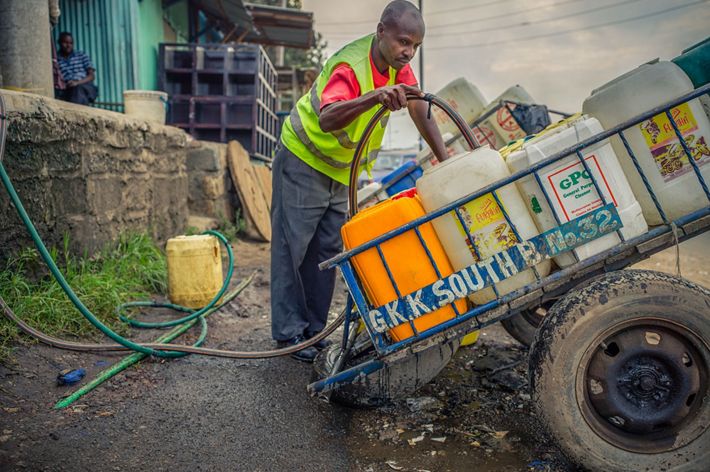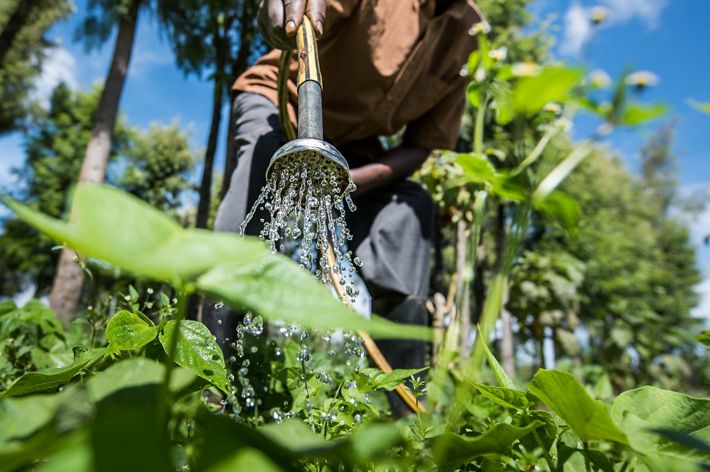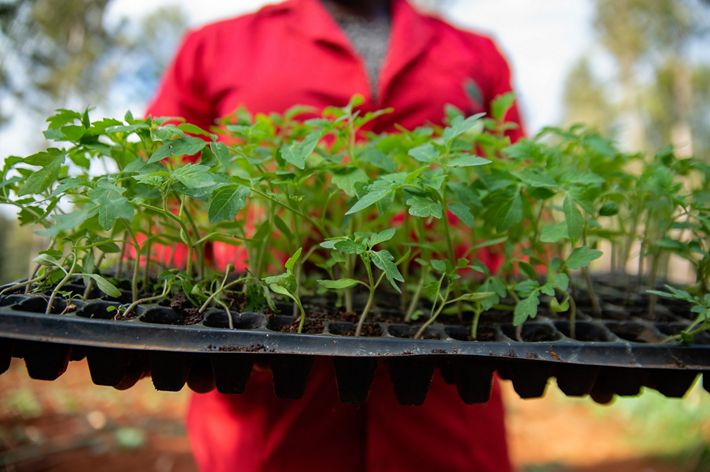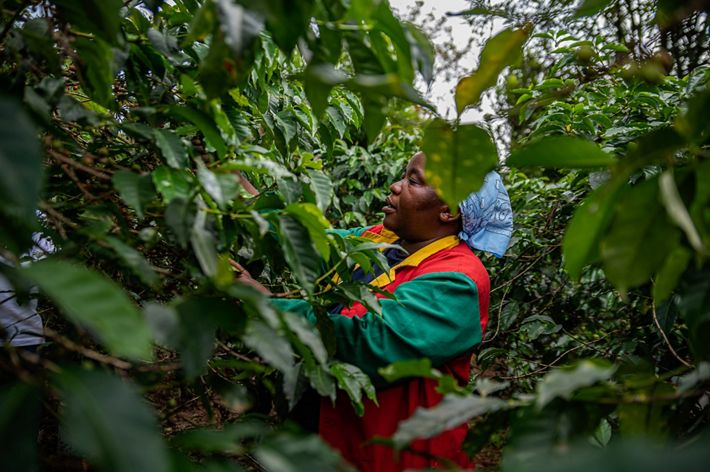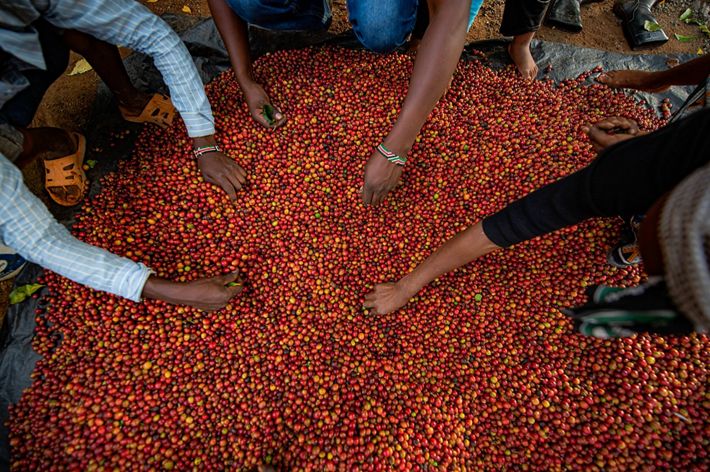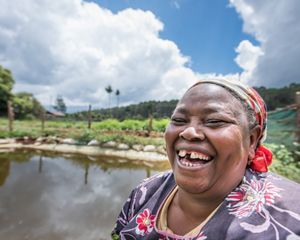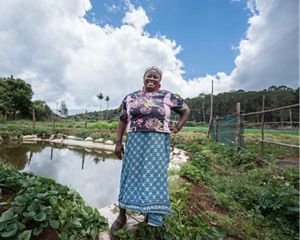
Africa's First Clean Water Fund is Already Seeing Success
The solutions to Nairobi's water shortages start upstream in the Tana River.
Fall 2019
Sitting at the edge of Kenya’s central highlands, Nairobi is a sprawling urban free-for-all. The city’s fringes contain a mix of ramshackle slums and meticulously manicured manor homes, while downtown, marabou storks wheel over new high-rises, as hawkers and minibuses duel for customers on the streets below.
Nairobi’s frenetic vitality draws people from across Kenya in search of economic opportunity. But at 4 million people and counting, the city is growing so fast that it’s coming apart at the seams. The problem is especially evident in the city’s water-supply system: 40% of the city’s water is lost to leaks and outright theft. Many Nairobians must buy their water from water tankers known as “bowsers,” or from mkokoteni, handcarts filled with 5-gallon water jugs pushed by roving peddlers. Water purchased on the private market can run 10 times the price of government-supplied water.
Quote
40% of the city’s water is lost to leaks and outright theft.
The headquarters of the Nairobi City Water and Sewerage Co. lies along a fantastically rutted road in the city’s industrial section. In his office, engineer Phillip Githinji lays out the stark reality: Even if the utility were to completely eliminate the problems of stolen and lost water, it would still only be able to meet about two-thirds of the city’s demand.
“There is a huge deficit,” he says—more than 66 million gallons a day. “And as population goes up, per capita supply will go down. We’re only able to supply new developments by shutting down others,” he says. “It’s the new normal.”
Water Management Techniques on Kenyan Farms
Now, in an effort to get a handle on Nairobi’s water problems, the utility is looking beyond the city’s boundaries. Nairobi’s water supply comes from the Tana River watershed to the north of the city. The landscape there is a mix of sprawling nature reserves and tightly packed family farms—about 300,000 of them, averaging only two-thirds of an acre. Nairobi Water is partnering with The Nature Conservancy and several local companies on a wide-reaching project that will link urban citizens with farmers in the rural headwaters region.
If it works, the program—known as the Upper Tana-Nairobi Water Fund—will improve the reliability of Nairobi’s water by ensuring that farmers upstream in the Upper Tana River basin take less water out of the river during dry times. It will also improve the quality of Nairobi’s water supply by keeping topsoil on farm fields.
One of those farmers is Esther Wandia, who cultivates a small plot of steep hillside some 30 miles north of Nairobi. Here, amid an undulating landscape of tea, eucalyptus and leafy banana trees, Nairobi’s intense energy feels a world away. Yet Wandia is connected with the city: Just downstream from her farm is Ndakaini Reservoir, from which Nairobi Water feeds its supply system.
With help from the water fund, Wandia planted a thicket of bamboo alongside a stream that runs along the bottom of her farm. The thick stalks now tower overhead and provide a silt-trapping buffer between Wandia’s farm and the stream. “You see the water is clean,” she says.
Quote: Esther Wandia
You see the water is clean.
The bamboo buffer is just one of several techniques that farmers are beginning to use to better manage water on their own farms. At the top of her farm, Wandia has installed a 13,000-gallon “water pan” to harvest rainwater. The plastic-lined retention pond provides a reliable water source, which Wandia sparingly meters out through the dry season to irrigate tea and avocado trees. It also means that she no longer has to pump water directly out of the stream that runs along the bottom edge of her farm—and that is good for Nairobi.
The Upper Tana-Nairobi Water Fund is only four years old, and its success is not guaranteed. Yet small steps can have a huge impact, not only for individual farmers like Wandia and their families, but across the entire watershed. In such a short time, the program has already reached 25,000 farmers—and it plans to reach twice that many by 2022. Its success depends on improving the lives of farmers.
How Nairobi’s Water Shortage Started
Back in Nairobi, Fred Kihara, who helped launch the project for TNC, knows firsthand what the precariousness of the city’s water supply feels like. “I’m one of the lucky people, with about three days of water” per week, he says. When the water comes, he says, he has to stockpile it in a tank and jerrycans to have enough to make it through the rest of the week.
The scale of the problem became apparent around 2012. “Nairobi realized it had a 30% shortfall between demand and supply,” Kihara says. “They could not meet 30% of demand every day of the year.” But TNC suggested that rather than building dams, treatment plants and other infrastructure downstream, Nairobi Water and others might embrace a newer approach: financing nature-based improvements near the Aberdare Mountains—the source of Nairobi’s water supply.
“Most of the time, you hear: ‘A bigger dam is what is needed,’ ” says Anthony Kariuki, who now oversees the water fund for TNC. But in an era where climate change is disrupting rainfall in this region, he says, “what if there is no water flowing? The bigger dam will only be a quarter full.”
This area’s “new normal” is a shift in rain patterns, where annual rainfall is up slightly but arrives over fewer rain days. This intensity exacerbates a few problems: Rainfalls wash soil down the rivers, forcing the city to use more expensive water-treatment techniques. And sediment that settles in reservoirs reduces both storage and power-generation capacity.
To finance this new kind of water-supply improvement program, TNC proposed establishing a water fund, a financing mechanism it has been developing for more than a decade. The idea is simple: Urban water users essentially tax themselves to fund water conservation and quality improvement efforts higher up in their watershed. In 2000, TNC launched its first water fund, in Quito, Ecuador. In the years since, TNC has helped establish more than 35 water funds worldwide.
Quote: Fred Kihara
I’m one of the lucky people, with about three days of water per week.
The Nature Conservancy began evaluating the potential for launching a water fund in Nairobi. Says Kihara, “In 2015, we did a business case study that said: We need to take this to scale. We need to protect the whole region.” The results were promising. “There’s a 2-to-1 benefit: For every dollar you invest, we get [more than] $2 of benefit out of it,” Kihara says. “If you invest $10 million, then you’re going to get $21 million in benefits”—primarily by reducing water-treatment costs, increasing hydropower production and improving harvests.
In 2015, TNC and its partners formally established the Upper Tana-Nairobi Water Fund, the first water fund in Africa. About $18 million in funding was secured from county governments, the International Fund for Agricultural Development, Kenya’s Ministry of Environment, an international partnership called the Global Environmental Facility and a long list of business partners, including the East Africa Breweries, the vegetable processor Frigoken, the Caterpillar Foundation, UPS and the Coca-Cola Foundation. For many businesses, water scarcity becomes a limiting factor in their operations.
According to Doris Kendi, who oversees sustainability operations for Nairobi Bottlers, the local Coca-Cola bottler, the soda is 90% water. “Water is critical for us,” she says. “Until we have enough hands doing something up there, our challenge downstream continues to get even bigger. And when there’s scarcity, then we all suffer.”
We Can Help Farmers Use Less Water in Kenya
Perched on a eucalyptus-dotted slope above Thika Reservoir, James and Esther Kariuki’s two-and-a-half-acre farm is a veritable cornucopia. It is planted with pumpkin, arrowroot, corn, amaranth, kale, spring onions, bananas, avocados and macadamia nuts, and they keep a cow for milk. Just downhill sits a thick carpet of tea trees—the source of most of the couple’s income.
A county extension officer named Carol Nguru has come to check on the Kariukis’ farm. As Nguru speaks with them, she pitches in to help pick tea. Nestled within the tea trees are several small avocado saplings, provided with the help of the water fund. As the saplings grow, they’ll provide important forest cover and also sequester carbon dioxide—as well as give farmers a new, high-value export crop. But Nguru casts a critical eye at one of the young avocado trees before she finally makes a pronouncement: “They need some boost.”
The soil here is acidic, so she suggests adding lime and manure to balance the pH. Within days, the water fund will broadcast a text message in Swahili to 18,000 farmers alerting them to the problem, suggesting a remedy and providing contact information in case they need help.
This text-message network has helped overcome some of the challenges of working with thousands of small farms scattered over Kenya’s hill country. The water fund uses text messages to survey farmers about their practices and needs, and to send technical advice and broadcast announcements about market events where new crop types will be distributed.
This kind of support is just part of a package of techniques that Anthony Kariuki, Kihara, Nguru and the water fund team are working to persuade local farmers to try, in order to take pressure off the rivers that Nairobi’s citizens depend on.
At the heart of the package are the water pans: hand-dug retention ponds that hold anywhere from 6,000 to 26,000 gallons of rainwater. The water pans help farmers stretch their available supply of water across the three-month gap between the “short rains” that end in December and the “long rains” that start in March. That, in turn, relieves their need to tap streams and rivers to make it through the dry spell. Farmers provide the labor to excavate the water pans, a process that can take three to four days; in exchange, the water fund covers 70% of the cost of the heavy-duty plastic liners that prevent leakage.
The fund also helps farmers reshape the steep, runoff-prone slopes on their farms into terraces, which better retain soil. That prevents streams and rivers from being choked with sediment while retaining topsoil, which helps boost crop yields.
In addition, farmers can slow water runoff and prevent soil erosion by planting strips of napier grass, which can also be used as animal fodder. Farmers are encouraged to plant their crops at least 20 feet from streams and rivers, which reduces the amount of sediment that runs off into waterways.
These improvements have helped open up new possibilities for farmers in the Upper Tana River basin. Conservancy staff set a goal to have 50,000 farmers engaging with the water fund by 2022—and they are already halfway to that mark.
Many of these improved farming techniques sell themselves, becuase they also increase reliability, yields and profits. Mercy Wangechi—better known to her neighbors as Mama Christine—is a local success story. Several years ago, a neighbor helped her construct a water pan on her farm, and it has proven to be a kind of economic springboard for her family.
Quote: Mama Christine
We have come far, and they want to know how.
Mama Christine has been particularly adept at using the water pan to irrigate crops in the dry season, like tomatoes, peppers and melons, when prices can be more than double what they would be at other times of the year. In 2015, she and her husband bought a station wagon so they could deliver crops directly to the local market, rather than relying on middlemen. They traded for a better car, and then in 2018 bought a minivan that she and her husband hire out as a chauffeured car service. The same year, they opened a minimart in Nairobi. More important, Mama Christine has used profits from the farm to pay school fees for her daughter and two sons.
“I have managed to do all those things,” she says, “because I have that water pan.” She has been using her tomatoes to spread the gospel of farming improvements. “When we take our tomatoes and melons to the market, people want to see where these things are grown, and they come to my farm,” she says. “We have come far, and they want to know how.”
Despite her diversification into other businesses, Mama Christine says she won’t ever leave the farm. “Most people don’t like farming; they say it’s dirty work,” she says. “But when you are done with it and go shopping, no one can tell the difference between a farmer and a doctor. We are all the same.”
Water Pans Are Making a Difference for Kenyans
On the outskirts of a town called Maragua, 40 miles northeast of Nairobi, Faith Mbathi unloads a water-flow measuring instrument, a water quality meter and a machete from the back of a car. Mbathi is a hydrological monitoring assistant for Nairobi Water Fund, and as she pulls on a pair of waders, she recounts how people in the area would sometimes get into fistfights over water. Then she hoists up the flow meter and, with a few deft swings of the machete, carves a path to the Githanja River. Here, the Githanja is barely wider than a brook, but “all these small streams add up to a big major river,” Mbathi says, “and that gives Nairobi city its water.”
These rivers also give Nairobi—and most of Kenya—its electricity. About 40% of the country’s hydropower is generated in the Upper Tana River area. But high levels of silt are reducing the water storage at reservoirs for facilities like Masinga Dam, just downstream from here. The dam was built to last 100 years, but under present sedimentation rates, its usable life span will be cut in half.
Mbathi checks the readout on her meter. “Good,” she says. “We can see the results. The data is still being analyzed, but we can already see there is a great improvement.”
Although the evidence is still largely anecdotal, it seems that there’s already been improvement not only in terms of water quality but also overall water quantity since the partnership began four years ago. Back in Nairobi, Kihara says, “We pushed the supply of water to Nairobi from 525 to 552 million liters per day”—an increase of more than 7 million gallons per day.
The Nature Conservancy is also working to assemble a $7.5 million endowment to support the fund, and plans to turn the fund’s operation over to local partners by 2022.
Across town, at the Nairobi Water headquarters, Phillip Githinji says the water fund has helped change how the utility thinks. “The water fund has brought focus and structure to the whole concept of conservation,” he says. “And that is why we see it as the way forward for the future.”
In fact, water funds offer promise beyond Nairobi. The need is acute. “Africa is growing and it’s growing fast,” says Kihara. “So one of the challenges that virtually all cities in Africa are facing is water.” Last year, TNC launched Africa’s second water fund in Cape Town, South Africa, where headlines about looming water shortages grabbed international attention. The Conservancy is also well along in the development of new water funds across the continent.
Back at her hilltop farm just upstream from Thika Reservoir, Esther Wandia carefully waters avocado seedlings, sheltered from the harsh midday sun in a shaded nursery built from rough timbers and branches.
“If it wasn’t for the water pan,” she says, “I wouldn’t be able to do this.” Wandia’s family has farmed here since 1962, but the margins have always been thin. Now, though, she is working toward a dream. The young avocados she’s watering are just some of the 10,000 seedlings she’s growing to sell to other farmers. The venture, she hopes, will earn her 1 million Kenyan shillings—about 10,000 U.S. dollars.
“I’m praying day and night, and working hard,” she says. “I’ve come from zero, and I’m going far.”
Download Report
-
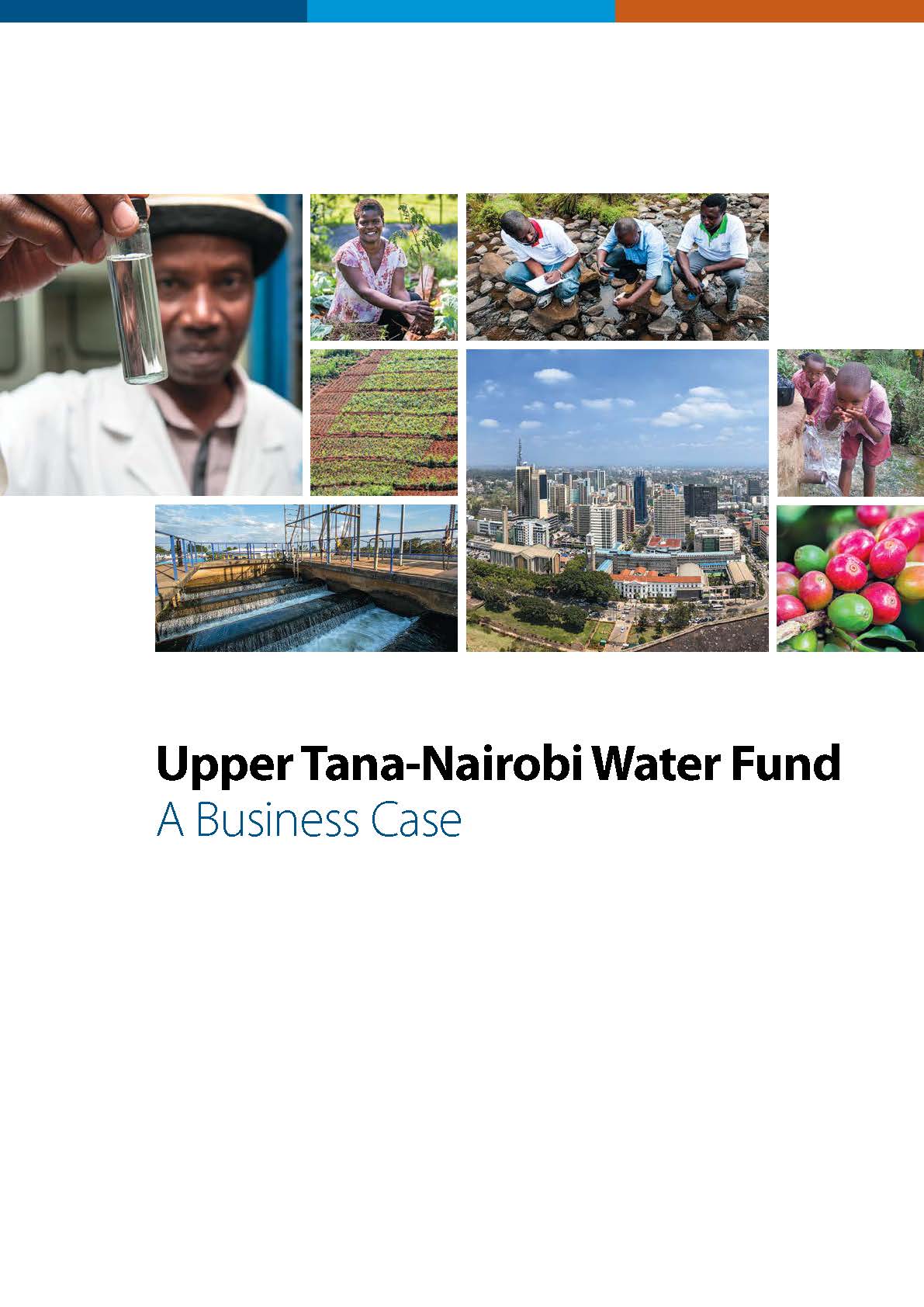 The Business Case for the Upper Tana-Nairobi Water Fund
The Business Case for the Upper Tana-Nairobi Water FundAssessing the impact and viability of the Upper Tana-Nairobi Water Fund.
Download

